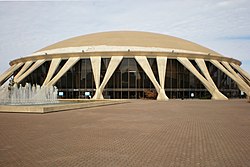
Back Norfolk Scope German Norfolk Scope French Norfolk Scope Italian 노퍽 스코프 Korean Norfolk Scope Polish Norfolk Scope Swedish
 | |
 | |
| Location | 201 East Brambleton Avenue Norfolk, Virginia 23510 |
|---|---|
| Owner | City of Norfolk |
| Operator | City of Norfolk |
| Capacity | Ice hockey: 8,701 Basketball: 10,253 Concerts: 13,800 Prism Theatre: ~4,000 |
| Construction | |
| Broke ground | June 6, 1968[1] |
| Opened | November 12, 1971 |
| Construction cost | $35 million ($263 million in 2023 dollars[2]) $14.5 million (upgrades since 2003) |
| Architect | Pier Luigi Nervi Williams and Tazewell |
| Structural engineer | Fraioli-Blum-Yesselman[3] |
| General contractor | Daniel Construction Co.[4] |
| Tenants | |
| Virginia Squires (ABA) (1971–1976) Old Dominion Monarchs (NCAA) (full time 1977–1990, part time 1971–2002) Hampton Roads Admirals (ECHL) (1989–2000) Norfolk Nighthawks (AF2) (2000–2003) Norfolk Admirals (AHL) (2000–2015) Norfolk SharX (MISL) (2011–2012) Norfolk Admirals (ECHL) (2015–present) | |
Norfolk Scope is a multi-function complex in Norfolk, Virginia, comprising the 11,000-seat Scope Arena, a 2,500-seat theater known as Chrysler Hall, a 65,000-square-foot (6,000 m2) modular exhibition hall, and a 600-car parking garage.
The arena was designed by Italian architect/engineer Pier Luigi Nervi in conjunction with the (now defunct) local firm Williams and Tazewell, which designed the entire complex. Nervi's design for the arena's reinforced concrete dome derived from the PalaLottomatica and the much smaller Palazzetto dello Sport, which were built in the 1950s for the 1960 Summer Olympics in Rome.
Construction on Scope began in June 1968 at the northern perimeter of Norfolk's downtown and was completed in 1971 at a cost of $35 million. Federal funds covered $23 million of the cost, and when it opened formally on November 12, 1971, the structure was the second-largest public complex in Virginia, behind only the Pentagon.[5]
Featuring the world's largest reinforced thinshell concrete dome (though eclipsed by the Seattle Kingdome from 1976 to 2000), Scope won the Virginia Society of the American Institute of Architects Test of Time award in 2003.[6] Wes Lewis, director of Old Dominion University's civil engineering technology program, called it "a beautiful marrying of art and engineering."[6] Noted architectural critic James Howard Kunstler described the design as looking like "yesterday's tomorrow."[6]
The name "Scope", a contraction of kaleidoscope,[7] emphasizes the venue's re-configurability. The facility logo (right), which features a multi-colored, abstracted kaleidoscope image, was designed by Raymond Loewy's firm Loewy/Snaith of New York.[7][8]
- ^ "Scope Cultural and Convention Center Groundbreaking Ceremony". Norfolk Redevelopment and Housing Authority. June 6, 1968. Archived from the original on March 4, 2016. Retrieved August 12, 2013.
- ^ 1634–1699: McCusker, J. J. (1997). How Much Is That in Real Money? A Historical Price Index for Use as a Deflator of Money Values in the Economy of the United States: Addenda et Corrigenda (PDF). American Antiquarian Society. 1700–1799: McCusker, J. J. (1992). How Much Is That in Real Money? A Historical Price Index for Use as a Deflator of Money Values in the Economy of the United States (PDF). American Antiquarian Society. 1800–present: Federal Reserve Bank of Minneapolis. "Consumer Price Index (estimate) 1800–". Retrieved February 29, 2024.
- ^ Norfolk Dome - Timeline: Important Precedents in Stadium Design
- ^ "Norfolk's Coliseum to Be Ready November 1". The Free Lance-Star. Fredericksburg. December 30, 1970. Retrieved February 20, 2012.
- ^ Walzer, Philip (July 25, 2011). "Architect Left His Mark on Many Iconic Norfolk Structures". The Virginian-Pilot. Norfolk. Retrieved July 26, 2011.
- ^ a b c "Norfolk's Scope Wins 'Time-Tested' Architecture Prize". Daily Press. Newport News. November 9, 2003. Archived from the original on January 31, 2013. Retrieved July 30, 2011.
- ^ a b Wilson, Patrick (March 23, 2009). "What's in a Name? Scope Arena, Norfolk". The Virginian-Pilot. Norfolk. Retrieved July 30, 2011.
- ^ "Celebrate America this July with Gary Kollberg's Exhibit at the Farmington Library". Farmington, CT: Farmington Library of Art. July 1, 2009.

